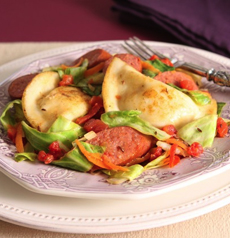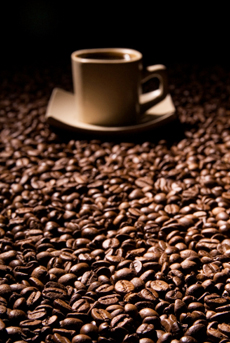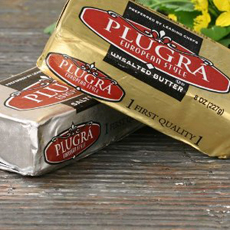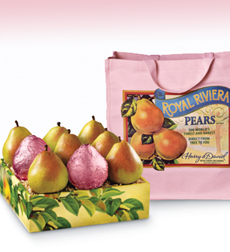
“Unstuffed cabbage” with pierogies.
Photo courtesy Mrs. T’s. |
|
Pierogi (pronounced PYEH-roe-gy and also spelled pierogy and a dozen other variations) is a stuffed dumpling, usually in a half-moon shape, that can be boiled, baked or fried. Although many Americans refer to “pierogies,“ the word “pierogi” is the plural form. The singular form is pieróg.
A form of stuffed pasta, pierogi are related to Italian ravioli and tortellini, the Ashkenazi Jewish kreplach, the Chinese wonton, the Japanese gyoza and numerous other “pillow pastas” (stuffed pasta dough) enjoyed by cultures worldwide.
Popular pierogi stuffings include cabbage, cheese, mashed potatoes, mushrooms, meat, onions, sauerkraut, spinach and other ingredients, alone or in combination. There are also fruit-filled dessert pierogi, stuffed with apple, berry, cherry, peach, plum and prune fillings.
|
|
Pierogi-making in the U.S. blossomed at the beginning of the 20th century, with the influx of immigrants from Eastern Europe. In the 1940s, pierogi became a staple of church fundraisers in Eastern European neighborhoods of the Northeast and Upper Midwest.
Mary Twardzik and her friends would gather around the kitchen table and make pierogi for their Pennsylvania church. Inspired by the popularity of the pierogi, her son Ted founded Mrs. T’s on October 8, 1952. Last year, the company helped to establish the first National Pierogi Day.
UNSTUFFED CABBAGE AND PIEROGI RECIPE
Ingredients
1 box (16 ounces) Mrs. T’s potato and cheddar pierogi
1 package (16 ounces) kielbasa, cut into 1-inch slices
1/2 tablespoon vegetable oil
1 head green cabbage, cut into 2-by-1-inch pieces
1 large onion, chopped
1 garlic clove, crushed
1 can (14.5 ounces) diced tomatoes
1 large carrot, shredded
1 teaspoon salt
1/2 teaspoon caraway seed
1/4 teaspoon ground black pepper
Preparation
1. Sauté pierogi as box directs.
2. In 12-inch skillet over medium-high heat, cook kielbasa slices until lightly browned. Stir frequently. Remove to bowl.
3. Cook cabbage and onion in same skillet, in hot oil over medium heat, until tender-crisp, about 5 minutes. Stir occasionally.
4. Add garlic, tomatoes with their liquid, carrot, salt, caraway seed, pepper and kielbasa. Heat to boiling over high heat. Reduce heat to low; cover and simmer 10 minutes, stirring occasionally.
5. Add pierogi to skillet; heat through and serve.
Serves 4.
|







